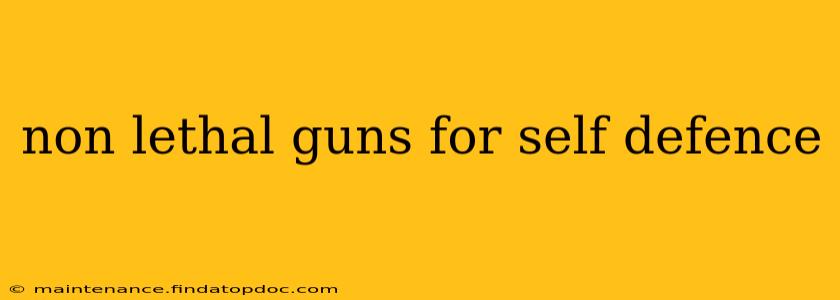Choosing the right self-defense tool is a serious decision, demanding careful consideration of legal implications, effectiveness, and personal capabilities. Non-lethal guns offer a potential alternative to firearms, aiming to incapacitate attackers without causing fatal injuries. However, it's crucial to understand their limitations and responsibilities before relying on them for self-protection. This guide will explore various options, addressing common questions and concerns.
What are Non-Lethal Guns?
Non-lethal guns, also known as less-lethal weapons, are designed to subdue individuals without causing death or severe permanent injury. They employ various mechanisms to achieve this, including deploying projectiles like rubber bullets, pepper spray, or tasers. The effectiveness and legality of these weapons vary significantly depending on the specific device, the situation, and your local laws.
What are the Different Types of Non-Lethal Guns?
Several types of non-lethal guns exist, each with its strengths and weaknesses:
1. Pepper Ball Guns:
These guns fire small projectiles filled with oleoresin capsicum (OC), the active ingredient in pepper spray. The impact and the subsequent exposure to OC can cause temporary incapacitation through intense burning and irritation of the eyes, skin, and respiratory system.
2. Paintball Guns:
While primarily used for recreational purposes, paintball guns can serve as a deterrent in self-defense situations. The impact of the paintballs can startle an attacker, and the visible marking can aid in identification and law enforcement investigation. However, their effectiveness is limited, and they lack the incapacitating power of other non-lethal options.
3. Air Guns (with Non-Lethal Ammunition):
Certain air guns, when loaded with non-lethal projectiles like rubber bullets or specially designed pellets, can be used for self-defense. The impact can cause pain and potentially stun an attacker. However, the risk of causing serious injury increases with higher-powered air guns.
4. Tasers (Stun Guns):
Tasers deliver a high-voltage, low-amperage electrical shock that temporarily incapacitates the target by disrupting nerve signals. They're known for their effectiveness in quickly disabling attackers. However, their use requires careful consideration due to potential risks to individuals with pre-existing heart conditions.
Are Non-Lethal Guns Legal?
The legality of non-lethal guns varies considerably by jurisdiction. Some regions have strict regulations on the ownership, carrying, and use of these weapons. It's essential to thoroughly research and understand the specific laws in your area before purchasing or using any non-lethal self-defense tool. Ignoring these laws can lead to serious legal consequences.
How Effective are Non-Lethal Guns for Self-Defense?
The effectiveness of non-lethal guns is highly dependent on several factors:
- The attacker's physical condition and state of mind: A highly intoxicated or enraged individual might not be as easily subdued.
- The distance between you and the attacker: The range of effectiveness varies considerably between different types of non-lethal weapons.
- Your proficiency with the weapon: Proper training and practice are crucial for effective use.
It's crucial to understand that no self-defense tool guarantees complete safety. Non-lethal weapons can fail to incapacitate an attacker, or worse, unintentionally escalate the situation.
What are the Risks and Responsibilities Associated with Using Non-Lethal Guns?
Using any self-defense weapon carries risks, including:
- Accidental injury: Misuse or malfunction can lead to accidental injuries to both the user and bystanders.
- Escalation of violence: An attacker might react violently in response to the use of a non-lethal weapon.
- Legal consequences: Improper use can result in legal charges, even if you were acting in self-defense.
Responsible use requires training, awareness of legal limitations, and a clear understanding of when and how to employ such a weapon. Always prioritize de-escalation tactics before resorting to self-defense.
Are there alternatives to non-lethal guns for self-defense?
Yes! Numerous alternatives exist, and focusing on preventative measures is often the best approach. These can include:
- Self-defense classes: Learning effective techniques and strategies can significantly improve your ability to protect yourself.
- Situational awareness: Paying attention to your surroundings and avoiding potentially dangerous situations is crucial.
- Personal alarms: A loud personal alarm can deter attackers and attract attention.
- Pepper spray: A small and easily accessible option for self-defense.
This information is for general knowledge and does not constitute legal advice. Always consult with relevant authorities and legal professionals before making decisions regarding self-defense tools and their use. Prioritize your safety and well-being by understanding the risks and responsibilities involved.
